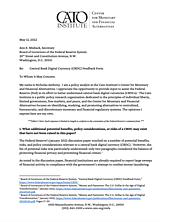To Whom It May Concern:
My name is Nicholas Anthony. I am a policy analyst at the Cato Institute’s Center for Monetary and Financial Alternatives. I appreciate the opportunity to provide input to assist the Federal Reserve (Fed) in its effort to better understand central bank digital currencies (CBDCs). The Cato Institute is a public policy research organization dedicated to the principles of individual liberty, limited government, free markets, and peace, and the Center for Monetary and Financial Alternatives focuses on identifying, studying, and promoting alternatives to centralized, bureaucratic, and discretionary monetary and financial regulatory systems. The opinions I express here are my own.
1. What additional potential benefits, policy considerations, or risks of a CBDC may exist that have not been raised in this paper?
The Federal Reserve’sJanuary 2022 discussion paper touched on a number of potential benefits, risks, and policy considerations relevant to a central bank digital currency (CBDC). However, the list of potential risks was particularly understated: only two paragraphs considered the balance of protecting financial privacy and preventing financial crimes.
As noted in the discussion paper, financial institutions are already required to report large sweeps of financial activity in compliance with the government’s attempt to combat money laundering and terrorist financing. In doing so, the paper appears to be suggesting that a CBDC would not be different from existing digital money. While it may be true that a CBDC could be largely identical to existing digital money, there would be a significant difference in that a CBDC would provide the opportunity to establish a direct line between the government and the public’s financial activity. In doing so, a CBDC would erase what little financial privacy still exists in the United States.

This work is licensed under a Creative Commons Attribution-NonCommercial-ShareAlike 4.0 International License.

